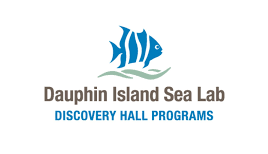DISL - Discovery Hall Offers Virtual Highschool Classes
March 15, 2021
The Virtual Classes listed below will be tailored for High School students. To learn more and to book a class, reach out to scheduler@disl.edu.
Adaptations in coastal Alabama's fishes
Fishes show many adaptations to their environment. This class explores the relationship between a fish's habitat and its body shape, its fins, and mouth shape using a wide variety of fishes from the waters of Alabama and the Gulf of Mexico.
Sharks and Rays of the Gulf of Mexico
Sharks and rays are fascinating animals. In this class, sharks and rays are compared and used to illustrate many aspects of animal biology, including skeletal, digestive, circulatory, excretory, and reproductive systems as well as human impacts on ocean ecosystems.
Sea Turtles and other Gulf coast reptiles
This class explores the biology of turtles, focusing on sea turtles but including other Gulf coast reptile species. With a focus on conservation, it presents the impacts of marine debris, climate change, fishing bycatch, and why many species of Gulf coast turtles are endangered.
Coastal Invertebrates of Alabama
Accounting for 97% of the Animal Kingdom, invertebrates have adapted to every habitat on planet earth from the bottom of the deep sea to the tops of mountains. In this class, students observe and learn about invertebrate biodiversity through preserved and live specimen demonstrations.
Exploring invertebrate animals through dissection
Squid are creatures of legend, but they are a key piece to the ocean food web as predator and prey. In this class, students dissect these unusual invertebrates to see what makes them so successful in the ocean and compare their anatomy to other animals.
Watersheds and water quality
We all live in a watershed. In this class, students learn about their watershed and explore its connection to the coast through an interactive app. Demonstrations illustrate how rivers and coastal waters mix, the impacts of human activities on the resulting water quality, and explore where students can find water quality information about their watershed.
Underwater robots and other tools of ocean exploration
With humans increasingly dependent on the ocean, marine technology has become an essential industry with applications from oil and gas exploration to the military. In this class, students explore a type of underwater robot, a Remotely Operated Vehicles (ROVs), and engage with engineering and design principles in designing and building an ROV.
Ocean waves and currents: the motion in the ocean
What creates a wave? Can a message in a bottle really drift around the world? Join us to investigate the physics of the ocean including waves, currents, and tides, examine real-time wave data, and explore the technology used by scientists to measure these phenomena. The class will build models of ocean drifters and test their engineering skills by experimenting with them around their Ocean.
Ocean zones, sonar, and ocean mapping
With sunlight penetrating only 1000 meters down into the ocean that AVERAGES over 4000 meters in depth, how do scientists know what the deep ocean is like? In this class, students will descend through the ocean zones from the surface to the Challenger Deep, learn how we know what we know about the deep ocean, and construct a model of ocean bathymetry.
Marine debris and microplastics
Where does litter in the ocean come from? Doesn't it biodegrade? In this class, students will explore marine and waterborne debris, investigate the impacts of debris on ocean animals and ecosystems, and identify solutions to this growing problem. Through an activity, we will identify microplastics and collect and categorize data on debris while participating in a citizen science project.
Barrier islands and beach ecology
Many students have been to the beach, but perhaps not realized the importance of these beautiful ecosystems in protecting the mainland and providing habitats for a variety of plants and animals. This class explores microscopic and macroscopic beach inhabitants living there, the adaptations these inhabitants show to living in this constantly changing habitat, and how beaches are created and changed by natural and human forces.
Climate change and ocean impacts
How are the earth's systems being affected by increased carbon dioxide (CO2) amounts in the atmosphere? This class explores the relationship between increased CO2 levels and sea-level rise, ocean acidification, and climate change. We'll demonstrate a number of short activities that model these effects and discuss ecological and community-based resilience.
Invasive species
Let the Sea Lab invade your classroom with specimens and stories of invasive species. We'll explore a case study of the lionfish through a mapping activity and learn how invasives are introduced, what it means to be invasive versus non-native or naturalized, and how invasive species impact biodiversity, ecosystems, and our economy.
Hurricanes, storm surge, and scientific modeling
Hurricanes are some of the most destructive natural forces on our planet. Students will learn what causes them, how they form, and how scientists track and predict their paths to limit human and economic losses. We'll explore the life cycle of a storm, past impacts with Google Earth, work with NOAA's hurricane tracker, and engage in a storm surge simulator to understand these natural phenomena.
Ocean plants and their adaptations
Does sitting out in the hot sun all day sound like fun? From the microscopic phytoplankton to the enormous kelp, this class explores the variety of adaptations seen in photosynthetic organisms found in the ocean. Students will explore the photosynthetic process and investigate ways plants work to capture sunlight and energy in a variety of ecosystems.
